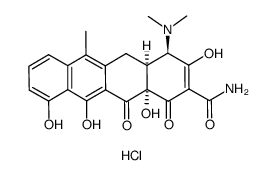4-Epianhydrotetracycline hydrochloride

4-Epianhydrotetracycline hydrochloride structure
|
Common Name | 4-Epianhydrotetracycline hydrochloride | ||
|---|---|---|---|---|
| CAS Number | 4465-65-0 | Molecular Weight | 462.88000 | |
| Density | N/A | Boiling Point | 618.6ºC at 760 mmHg | |
| Molecular Formula | C22H23ClN2O7 | Melting Point | 220ºC | |
| MSDS | Chinese USA | Flash Point | 327.9ºC | |
|
Pre-microRNA binding aminoglycosides and antitumor drugs as inhibitors of Dicer catalyzed microRNA processing.
Bioorg. Med. Chem. Lett. 22 , 1709-11, (2012) Over-expressions of miRNAs are being increasingly linked with many diseases including different types of cancer. In this study, the role of some known small molecular therapeutics has been investigated for their ability to bind with the pre-miRNA target (hsa-... |
|
|
Development of a repressible mycobacterial promoter system based on two transcriptional repressors.
Nucleic Acids Res. 38(12) , e134, (2010) Tightly regulated gene expression systems represent invaluable tools for studying gene function and for the validation of drug targets in bacteria. While several regulated bacterial promoters have been characterized, few of them have been successfully used in... |
|
|
[A precise equilibrium equation for four steps of binding between TBP and TATA-box allows for the prediction of phenotypical expression upon mutation].
Biofizika 55(3) , 400-14, (2010) Among the main events of transcription initiation of TATA-containing genes in eukayotes are the recognition and binding of the TATA-box by the TATA-binding protein (TBP) to start the preinitiation complex formation on the nucleosomal DNA. Using the equilibriu... |
|
|
The bacterial nanorecorder: engineering E. coli to function as a chemical recording device.
PLoS ONE 6(11) , e27559, (2011) Synthetic biology is an emerging branch of molecular biology that uses synthetic genetic constructs to create man-made cells or organisms that are capable of performing novel and/or useful applications. Using a synthetic chemically sensitive genetic toggle sw... |
|
|
A plasminogen-activating protease specifically controls the development of primary pneumonic plague.
Science 315(5811) , 509-13, (2007) Primary pneumonic plague is transmitted easily, progresses rapidly, and causes high mortality, but the mechanisms by which Yersinia pestis overwhelms the lungs are largely unknown. We show that the plasminogen activator Pla is essential for Y. pestis to cause... |
|
|
Identification of a toxic peptide through bidirectional expression of small RNAs.
ChemBioChem. 10(2) , 238-41, (2009)
|
|
|
Further characterization of Bacillus subtilis antibiotic biosensors and their use for antibacterial mode-of-action studies.
Antimicrob. Agents Chemother. 55(4) , 1784-6, (2011) We further examined the usefulness of previously reported Bacillus subtilis biosensors for antibacterial mode-of-action studies. The biosensors could not detect the tRNA synthetase inhibitors mupirocin, indolmycin, and borrelidin, some inhibitors of peptidogl... |
|
|
Formation of tetracycline degradation products in chicken and pig meat under different thermal processing conditions.
J. Agric. Food Chem. 55(11) , 4610-6, (2007) Tetracycline (TC) and 4-epitetracycline (4eTC) degradation, as well as anhydrotetracycline (ATC) and 4-epianhydrotetracycline (4eATC) formation, has been evaluated in thermally treated chicken breast, pig loin, and pig loin with added back-fat. Samples contai... |
|
|
Development of a single-plasmid-based regulatable gene expression system for Borrelia burgdorferi.
Appl. Environ. Microbiol. 75(20) , 6553-8, (2009) We developed a single-plasmid-based regulatable protein expression system for Borrelia burgdorferi. Expression of a target gene is driven by P(ost), a hybrid B. burgdorferi ospA-tetO promoter, from a recombinant B. burgdorferi plasmid constitutively expressin... |
|
|
Identifying the minimal enzymes required for anhydrotetracycline biosynthesis.
J. Am. Chem. Soc. 130(19) , 6068-9, (2008) The cyclohexenone ring A of tetracyclines exhibits unique structural features not observed among other aromatic polyketides. These substitutions include the C2 primary amide, C4 dimethylamine, and the C12a tertiary alcohol. Here we report the identification a... |